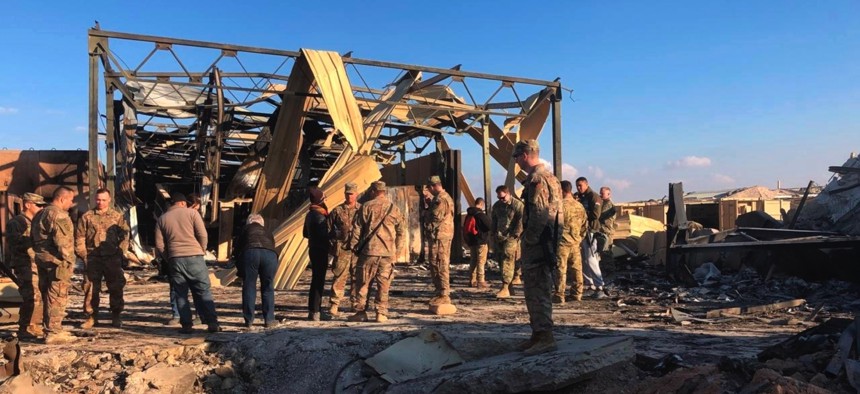
U.S. soldiers stand at a site of Iranian bombing at Ain al-Asad air base in Anbar, Iraq, Monday, Jan. 13, 2020. AP / Qassim Abdul-Zahra
34 Injured in Iran Attack, Pentagon Now Says; Launches a Review of Reporting Procedures
SecDef Mark Esper ordered a review of “processes for tracking and reporting injuries” after criticism in the wake of the Iranian missile attack.
Thirty-four U.S. troops have been diagnosed with concussions and other traumatic brain injuries suffered in the Jan. 8 Iranian missile attack in Iraq, senior Pentagon spokesman Jonathan Hoffman said Friday.
Of those, 17 have returned to active duty, Hoffman said. Eight arrived in the United States today for continuing out-patient treatment, and nine remain at the medical facility in Landstuhl, Germany. Sixteen were diagnosed in Iraq, remained there, and have since returned to active duty.
Hoffman described those figures as a “snapshot in time” and said they could change in coming days.
Defense Secretary Mark Esper has ordered a review of “processes for tracking and reporting injuries,” Hoffman said.
The department has come under fierce scrutiny for the lag-time in the reporting of injuries from the missile attack. President Trump after the attack said that no troops had been injured; only after media outlets, including Defense One, began to report concussions and other TBIs did U.S. Central Command issue a statement acknowledging the injuries — eleven service members, originally.
“A lot of these symptoms are late-developing. They manifest over a period of time,” Hoffman said Friday. “Do we report when someone just shows up with a symptom? Do we wait until we suspect something? Do we wait until they have a full diagnosis? Do we wait until they’re evacuated from the region and are no longer available for duty?”
“That’s the case in what happened in this case. The reporting did not come up until they were actually evacuated from the area and taken to Germany for further treatment, and at that point they were lost to the formation and the secretary was made aware.”
But he acknowledged that there needs to be more “clarity” in how injuries are reported within DOD, and by extension, to the public.
“The secretary’s direction is focused on the fact if you look at the different types of reporting systems we have, sometimes the administrative reporting of an injury is different than the medical reporting,” he said. “We need to get that clarified.”
On Wednesday, President Donald Trump downplayed the injuries as “headaches.”
“I heard that they had headaches, and a couple of other things, but I would say, and I can report, it's not very serious,” Trump said in Davos, Switzerland.
The president has previously said that he would be reluctant to allow his young son to play football because of the danger associated with head injuries common in the sport.
Trump’s remark that he did not consider TBIs to be “very serious” struck some veterans’ advocates as deeply callous — and appeared to contradict the seriousness with which the Defense Department itself handles concussions and other TBIs. The Pentagon and the VA have spent “billions” researching, diagnosing and treating such injuries, according to Phillip Carter, now a veterans expert with RAND. The Army, which as part of the Defense Department designates March as “TBI Awareness Month,” calls it the “signature wound” of the wars in Iraq and Afghanistan.
Some analysts have speculated that Trump’s comments may have been an effort to deescalate tensions with Iran, given that he has in the past made attacks on U.S. personnel a “red line.”
Former DOD officials say that the more time passes, the less valid that excuse becomes.
“It's plausible that the day after the attack, both wanting to de-escalate tensions and because the extent of the injuries was likely not yet known, there was reason not to release the injury information,” tweeted former DOD spokesman David Lapan. “However, those reasons diminished in the following days, not 2 weeks later.”




